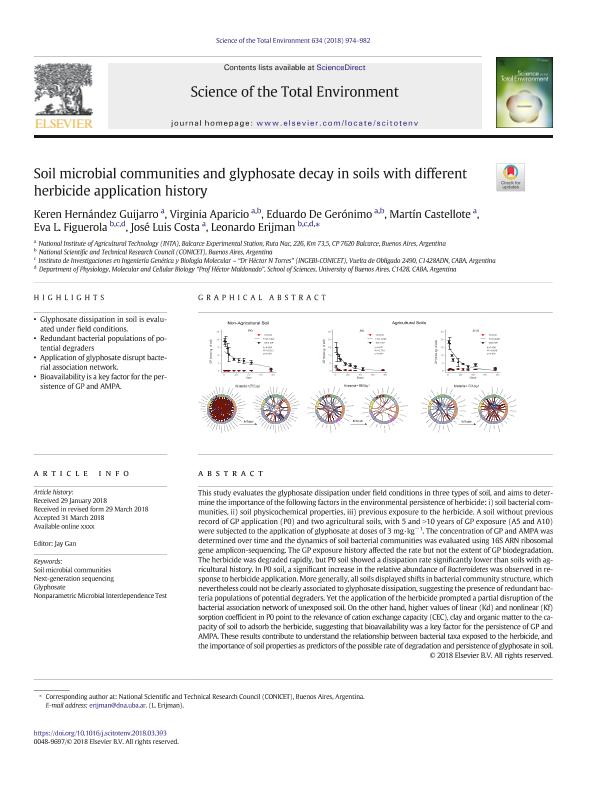Artículo
Soil microbial communities and glyphosate decay in soils with different herbicide application history
Hernández Guijarro, Keren; Aparicio, Virginia Carolina ; de Gerónimo, Eduardo
; de Gerónimo, Eduardo ; Castellote, Martín Alfredo; Figuerola, Eva Lucia Margarita
; Castellote, Martín Alfredo; Figuerola, Eva Lucia Margarita ; Costa, Jose Luis; Erijman, Leonardo
; Costa, Jose Luis; Erijman, Leonardo
 ; de Gerónimo, Eduardo
; de Gerónimo, Eduardo ; Castellote, Martín Alfredo; Figuerola, Eva Lucia Margarita
; Castellote, Martín Alfredo; Figuerola, Eva Lucia Margarita ; Costa, Jose Luis; Erijman, Leonardo
; Costa, Jose Luis; Erijman, Leonardo
Fecha de publicación:
09/2018
Editorial:
Elsevier
Revista:
Science of the Total Environment
ISSN:
0048-9697
Idioma:
Inglés
Tipo de recurso:
Artículo publicado
Clasificación temática:
Resumen
This study evaluates the glyphosate dissipation under field conditions in three types of soil, and aims to determine the importance of the following factors in the environmental persistence of herbicide: i) soil bacterial communities, ii) soil physicochemical properties, iii) previous exposure to the herbicide. A soil without previous record of GP application (P0) and two agricultural soils, with 5 and >10 years of GP exposure (A5 and A10) were subjected to the application of glyphosate at doses of 3 mg·kg−1. The concentration of GP and AMPA was determined over time and the dynamics of soil bacterial communities was evaluated using 16S ARN ribosomal gene amplicon-sequencing. The GP exposure history affected the rate but not the extent of GP biodegradation. The herbicide was degraded rapidly, but P0 soil showed a dissipation rate significantly lower than soils with agricultural history. In P0 soil, a significant increase in the relative abundance of Bacteroidetes was observed in response to herbicide application. More generally, all soils displayed shifts in bacterial community structure, which nevertheless could not be clearly associated to glyphosate dissipation, suggesting the presence of redundant bacteria populations of potential degraders. Yet the application of the herbicide prompted a partial disruption of the bacterial association network of unexposed soil. On the other hand, higher values of linear (Kd) and nonlinear (Kf) sorption coefficient in P0 point to the relevance of cation exchange capacity (CEC), clay and organic matter to the capacity of soil to adsorb the herbicide, suggesting that bioavailability was a key factor for the persistence of GP and AMPA. These results contribute to understand the relationship between bacterial taxa exposed to the herbicide, and the importance of soil properties as predictors of the possible rate of degradation and persistence of glyphosate in soil.
Palabras clave:
SOIL MICROBIAL ECOLOGY
,
GLYPHOSATE
Archivos asociados
Licencia
Identificadores
Colecciones
Articulos(CCT - MAR DEL PLATA)
Articulos de CTRO.CIENTIFICO TECNOL.CONICET - MAR DEL PLATA
Articulos de CTRO.CIENTIFICO TECNOL.CONICET - MAR DEL PLATA
Articulos(INGEBI)
Articulos de INST.DE INVEST.EN ING.GENETICA Y BIOL.MOLECULAR "DR. HECTOR N TORRES"
Articulos de INST.DE INVEST.EN ING.GENETICA Y BIOL.MOLECULAR "DR. HECTOR N TORRES"
Citación
Hernández Guijarro, Keren; Aparicio, Virginia Carolina; de Gerónimo, Eduardo; Castellote, Martín Alfredo; Figuerola, Eva Lucia Margarita; et al.; Soil microbial communities and glyphosate decay in soils with different herbicide application history; Elsevier; Science of the Total Environment; 634; 9-2018; 974-982
Compartir
Altmétricas



